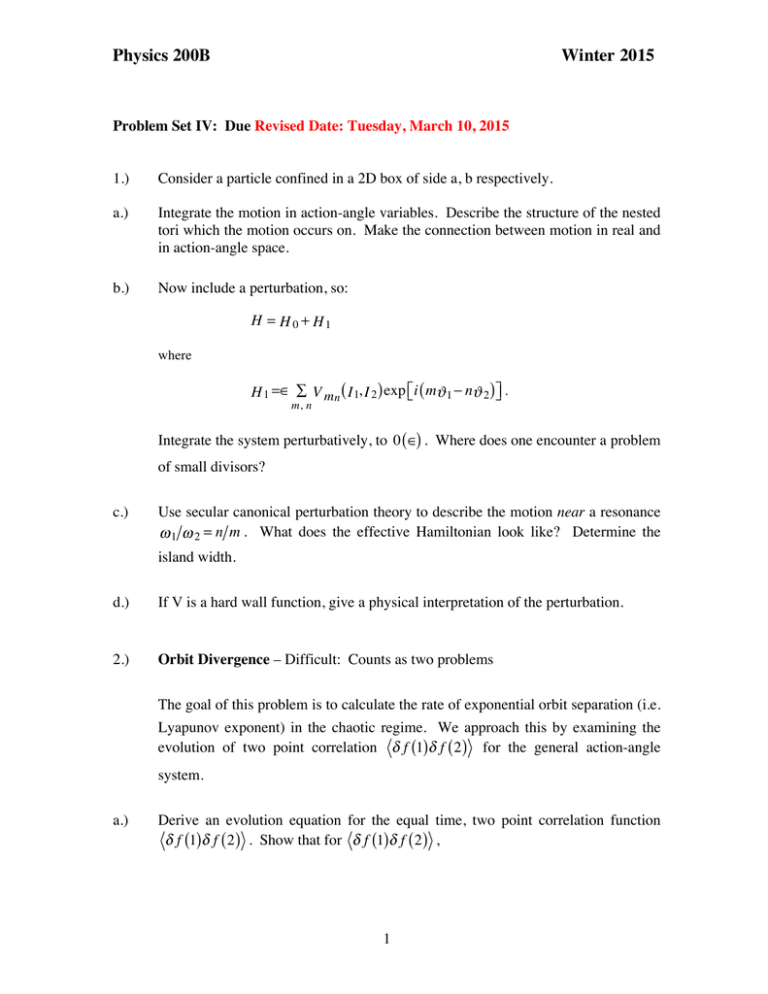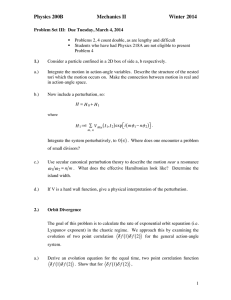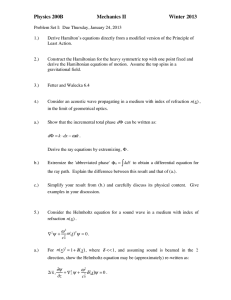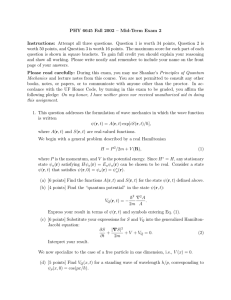Physics 200B Winter 2015
advertisement

Physics 200B Winter 2015 Problem Set IV: Due Revised Date: Tuesday, March 10, 2015 1.) Consider a particle confined in a 2D box of side a, b respectively. a.) Integrate the motion in action-angle variables. Describe the structure of the nested tori which the motion occurs on. Make the connection between motion in real and in action-angle space. b.) Now include a perturbation, so: H = H 0 + H1 where H 1 =! " V m n ( I 1, I 2 ) exp %&i ( m# 1 $ n# 2 ) '( . m, n Integrate the system perturbatively, to 0 ( !) . Where does one encounter a problem of small divisors? c.) Use secular canonical perturbation theory to describe the motion near a resonance ! 1 ! 2 = n m . What does the effective Hamiltonian look like? Determine the island width. d.) If V is a hard wall function, give a physical interpretation of the perturbation. 2.) Orbit Divergence – Difficult: Counts as two problems The goal of this problem is to calculate the rate of exponential orbit separation (i.e. Lyapunov exponent) in the chaotic regime. We approach this by examining the evolution of two point correlation ! f (1)! f ( 2 ) for the general action-angle system. a.) Derive an evolution equation for the equal time, two point correlation function ! f (1)! f ( 2 ) . Show that for ! f (1)! f ( 2 ) , 1 Physics 200B Winter 2015 % ! ! ! ( " f (1)" f ( 2 ) + ' # ( J 1) + # ( J 2) " f (1)" f ( 2 ) !t !$ 1 !$ 2 *) & ! " " Ĥ 1 " " Ĥ 2 $ f (1)$ f ( 2 ) ! $ f (1)$ f ( 2 ) " J 1 "# 1 " J 2 "# 2 = 0. What is the problem we must confront here? b.) Now use the mean field quasilinear closure methods to truncate the hierarchy. Note that a response at 2 points is required. Show that: % ! ! ! ( " f (1)" f ( 2 ) + ' # ( J 1) + # ( J 2) " f (1)" f ( 2 ) !t !$ 1 !$ 2 *) & ! " " D " # f (1)# f ( 2 ) ! # f (1)# f ( 2 ) D1, 1 D 2, 2 "J1 "J1 "J1 "J 2 ! " " " " # f (1)# f ( 2 ) ! # f (1)# f ( 2 ) D1, 2 D 2, 1 "J1 "J 2 "J 2 "J1 = 0. Calculate D1, 1 , D 2, 2 , D1, 2 and D 2, 1 . What is the relation of D1, 2 and D 2, 1 to D1, 1 and D 2, 2 ? c.) Now, change variables to relative (i.e. J _ = ( J 1 ! J 2 ) 2 , ! _ = (! 1 " ! 2 ) 2 ) and centroid (i.e. J + = ( J 1 + J 2 ) 2 , ! + = (! 1 + ! 2 ) 2 ) coordinates. Assume ! f (1)! f ( 2 ) evolution depends only on relative coordinates. Why is this reasonable? Thus, derive an evolution equation for ! f (1)! f ( 2 ) due to relative winding and relative diffusion. Discuss how these couple. d.) Discuss the physics of relative winding and relative diffusion. What properties of the dynamics do these depend upon? e.) Now, expand the relative diffusion term for small separation. Then take moments of the ! f (1)! f ( 2 ) equation to determine the rate of orbit separation. Comment on the relation of your result to the orbit decorrelation time derived in class. 2 Physics 200B 3.) Winter 2015 Another look at resonant tori Read carefully the discussion of resonant tori, the Poincare-Birkoff theorem and the eventual destruction of resonant tori in Ott, Chapter 7. a.) Summarize this story in your own words using simple ideas and pictures. Why is this of interest to our discussion of Hamiltonian chaos? b.) Discuss the correspondence between the approach followed in Ott and the more traditional and calculational approach followed in class. A table showing correspondences would be a good way to answer this question. c.) What do we learn from the more general approach of Ott, that the calculation in class doesn’t tell us? Likewise, what does our in-class discussion yield that is not contained in Ott’s account? 4.) Eine kleine Plasma Physics Consider a dynamical system of a particle in 1D scattered by a spectrum of electric fields, i.e. dx dt = v dv dt = q E m ! = "! k n cos ( k nx # $ ( k n ) t ) . n Take k n to be quantized (i.e. the particle is in a box of length L). a.) Assume a monochromatic spectrum. Where does perturbative integrability run into problems? What is the physical meaning of the resonance? b.) Again, for a monochromatic wave, derive the effective Hamiltonian and island width. What is the physical interpretation of the island width? c.) For a spectrum of fields, what is the condition for chaos? Estimate the critical amplitude of ! for the onset of chaos. Relate your answer to the box size. d.) Assuming the particle has Liouville f, derive the equation for f. e.) Derive an evolution equation for here? f.) Define the Kubo number for this system. What determines the autocorrelation time? Compare the condition for K u < 1 to the condition for the onset of chaos. f . Explain the physics. What does the average mean 3 Physics 200B Winter 2015 5.) Ott, Chapter 7, Problem 2 6.) Consider that a spectrum of electrostatic waves is applied to a particle, as in Problem 4. a.) If the wave amplitudes are sufficient to satisfy the Chirikov criterion, calculate the rate of increase in the particle’s kinetic energy. b.) What is the energy source, and when will the heating saturate? Justify your answer. c.) When will the mean field approach fail? Quantify your answer. 7a.) Derive the wave kinetic equation (adiabatic equation) for the population N ( x, k,t ) in the x, k phase space. b.) Assume a spectrum of refracting perturbations modulates the wave frequency, when will the wave rays be stochastic? c.) Derive the mean field equation for N . d.) How does the wave energy change on account of the stochastic refraction. Why does the energy change? e.) Define the Kubo number for this system. 4









